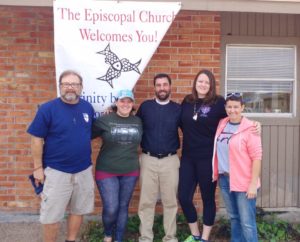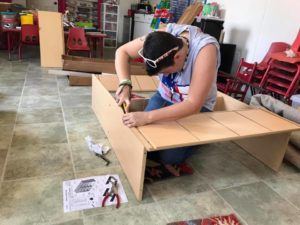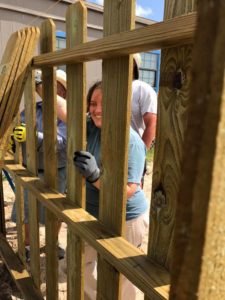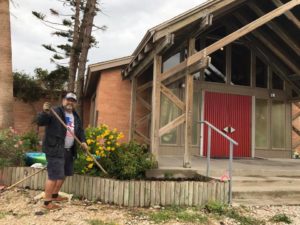Group works in Port Aransas rebuilding school
As rains from Hurricane Harvey still fell, students on the campus of Seminary of the Southwest were already thinking of where and how they could help those affected by the storms. (Read more about the weeks following the storm) Among these efforts, seminarians Lauren Kay and Christine Brunson actively sought out opportunities for themselves and other seminarians, and joined one of the Harvey relief task forces at The Episcopal Church of the Good Shepherd, a parish here in Austin, TX.
 Kay explained how that relationship led to a group of students working in Port Aransas over Fall Break: “As Christine and I worked with the Good Shepherd Episcopal Church’s Harvey relief Task Forces, and I worked with coordinating relief opportunities with the seminary, we talked with other seminarians about a possible fall break relief trip. Good Shepherd offered a generous donation to help fund the trip. The SSW fall break relief team formed as Christine, Peter (Thaddeus), Radha (Kaminski), and myself. Peter, being from the Diocese of West Texas, desired to serve somewhere along the coastal bend. Three of us had ties to Port Aransas and Trinity by the Sea, and after having the opportunity to speak with James Derkits while he was on campus, made the request to serve in Port A to the Diocese of West Texas disaster coordinators. Peter coordinated with DWTX. They graciously put us up at Mustang Island Conference Center, and our work with Trinity by the Sea primarily focused on helping them get their school ready to re-open the following Monday.”
Kay explained how that relationship led to a group of students working in Port Aransas over Fall Break: “As Christine and I worked with the Good Shepherd Episcopal Church’s Harvey relief Task Forces, and I worked with coordinating relief opportunities with the seminary, we talked with other seminarians about a possible fall break relief trip. Good Shepherd offered a generous donation to help fund the trip. The SSW fall break relief team formed as Christine, Peter (Thaddeus), Radha (Kaminski), and myself. Peter, being from the Diocese of West Texas, desired to serve somewhere along the coastal bend. Three of us had ties to Port Aransas and Trinity by the Sea, and after having the opportunity to speak with James Derkits while he was on campus, made the request to serve in Port A to the Diocese of West Texas disaster coordinators. Peter coordinated with DWTX. They graciously put us up at Mustang Island Conference Center, and our work with Trinity by the Sea primarily focused on helping them get their school ready to re-open the following Monday.”
The group of four was put to work almost immediately after being confronted with the overwhelming need.
“My time working on the Gulf Coast was filled with experiences for growth in ministry. We began the trip by touring the most damaged areas of Rockport, Port Aransas, and surrounding areas. We then joined the residents for Sunday morning services and fellowship hour. We listened to the residents, we learned to pinpoint needs we were capable of meeting in our timeframe, and we worked hard to do all we could to meet those needs. We came to Port Aransas expecting to gut houses and clean mold. We quickly found ourselves meeting needs in a myriad of ways–from building shelves and doing landscaping, to remodeling a school playground and buying much needed supplies for the teachers. I came to Port Aransas to learn and serve. When I left, I realized how much I learned about resiliency in ministry. We were so touched by our experiences there and we are looking forward to returning as soon as we can,” shared Brunson.
The Very Rev. Cynthia Briggs Kittredge, Dean and President, noted, “Our students showed compassion and wisdom as they organized the response to the overwhelming needs in the wake of the storms. They stayed in touch with each other, coordinated their efforts, and partnered with others to be most effective in a sustainable way. I am very proud of our students who model servant leadership within and beyond the seminary community.”
 Kay, who chairs the Disaster Relief subcommittee of the Southwest student council, reflected on the power of simply being present: “I am reminded of the importance of bearing witness, of what it means to bear witness. When we are removed from a situation and only see images on screens, it is impossible to grasp the scope of disaster. Driving through Rockport, where the eye came on shore, driving through Port Aransas, where the streets lined with storey high piles of debris means progress is being made, to see the new ‘dumps’ full of mountains of debris already collected, to see the places where all that is left of someone’s home is a mailbox, to talk with locals who lost everything, yet to hear their love for their community and see the resilience of residents… It is important to be there, and to come back here and share what we saw and what we heard. Port Aransas and Rockport left the spotlight shortly after Harvey hit. People need to know that they still need help, and they still have a long road ahead of them.”
Kay, who chairs the Disaster Relief subcommittee of the Southwest student council, reflected on the power of simply being present: “I am reminded of the importance of bearing witness, of what it means to bear witness. When we are removed from a situation and only see images on screens, it is impossible to grasp the scope of disaster. Driving through Rockport, where the eye came on shore, driving through Port Aransas, where the streets lined with storey high piles of debris means progress is being made, to see the new ‘dumps’ full of mountains of debris already collected, to see the places where all that is left of someone’s home is a mailbox, to talk with locals who lost everything, yet to hear their love for their community and see the resilience of residents… It is important to be there, and to come back here and share what we saw and what we heard. Port Aransas and Rockport left the spotlight shortly after Harvey hit. People need to know that they still need help, and they still have a long road ahead of them.”
The experience of being so embedded within the community highlighted for Kay other, less obvious needs that have enormous impact. One such need she wanted to highlight was Homes for Displaced Marlins. Said Kay, “This is an organization trying to get students transitioned back into the community to keep the local schools eligible for funding. After talking with several people, we understand it to be an important and very worthwhile cause.”



